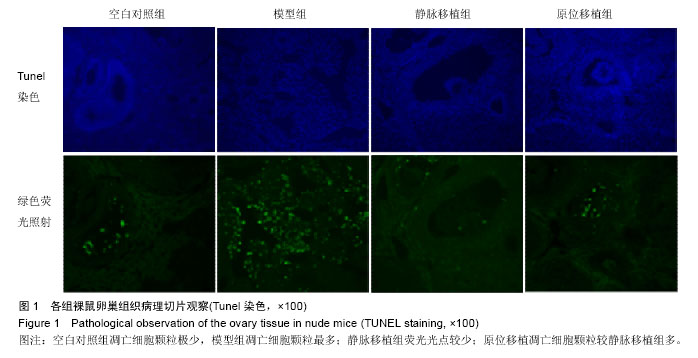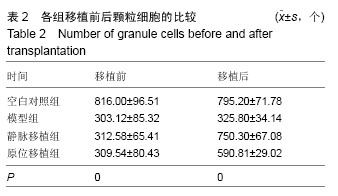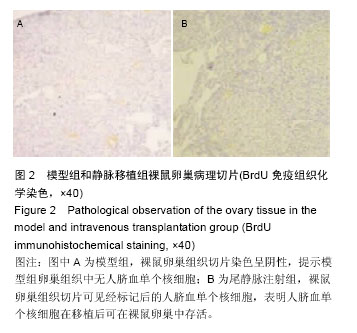中国组织工程研究 ›› 2016, Vol. 20 ›› Issue (36): 5398-5404.doi: 10.3969/j.issn.2095-4344.2016.36.012
• 干细胞移植 stem cell transplantation • 上一篇 下一篇
人脐血单个核细胞移植治疗裸鼠放射性卵巢早衰
王毅峰1,宋文广2,刘淑霞1
- 河北医科大学附属唐山工人医院,1妇一科,2放化疗科,河北省唐山市 063000
Human umbilical cord blood mononuclear cell transplantation for treatment of radioactive premature ovarian failure in nude mice
Wang Yi-feng1, Song Wen-guang2, Liu Shu-xia1
- 1Department of Gynecology, 2Department of Chemoradiotherpay, Tangshan Worker’s Hospital of Hebei Medical University, Tangshan 063000, Hebei Province, China
摘要:
文章快速阅读:
.jpg)
文题释义: 脐血单个核细胞:脐血中的单个核细胞含有大量间质干细胞、未成熟的干/祖细胞、内皮祖细胞等,可作为干细胞移植的重要来源。人脐血干细胞移植可用于治疗多种疾病,如急性心肌梗死、卵巢早衰、血管性痴呆、迟发脑病及各种妇科疾病。 卵巢早衰:是指女性在未满40岁,由于卵巢功能衰竭而导闭经、雌激素分泌下降、促性腺激素升高、不孕、围绝经期综合征的一种多病因疾病。
摘要 背景:干细胞移植成为近年来成为治疗卵巢早衰的热点之一;脐血中的单个核细胞含有大量间质干细胞、未成熟的干/祖细胞、内皮祖细胞等,可作为干细胞移植的重要来源。 目的:观察人脐血单个核细胞移植对裸鼠放射性卵巢早衰的治疗作用。 方法:将120只雌性BALB/C裸鼠随机分为4组,空白对照组不进行任何干预;模型组、静脉移植组、原位移植组进行60Coγ射线照射,0.5 Gy/d,持续30 d,建立卵巢早衰模型;造模成功后,模型组双侧卵巢注入10 µL DMEM,静脉移植组尾静脉注射10 µL人脐血单个核细胞(1×1013 L-1),原位移植组在双侧卵巢注入10 µL人脐血单个核细胞(1×1013 L-1)。细胞移植30 d后,检测各组血清中雌二醇、卵泡激素、黄体生成素、抑制素B及血管内皮生长因子水平,病理观察裸鼠卵巢组织细胞凋亡及静脉移植组细胞存活情况。 结果与结论:①血清指标检测结果:与空白对照组比较,模型组雌二醇、抑制素B、血管内皮生长因子水平降低(P < 0.01),卵泡激素、黄体生成素水平升高(P < 0.01)。与模型组比较,原位移植组雌二醇、抑制素B、血管内皮生长因子水平升高(P < 0.01),卵泡激素、黄体生成素水平降低(P < 0.01);静脉移植组卵泡激素、黄体生成素水平降低(P < 0.05,P < 0.01);②细胞凋亡:与模型组比较,静脉移植组、原位移植组可有效减少颗粒细胞的凋亡(P < 0.05);③细胞存活:人脐血单个核细胞移植后可在裸鼠卵巢中存活;④结果表明:人脐血单个核细胞移植治疗裸鼠卵巢早衰,可调节内分泌水平,抑制卵巢细胞凋亡。
中国组织工程研究杂志出版内容重点:干细胞;骨髓干细胞;造血干细胞;脂肪干细胞;肿瘤干细胞;胚胎干细胞;脐带脐血干细胞;干细胞诱导;干细胞分化;组织工程 ORCID: 0000-0002-3008-1505(王毅峰)
中图分类号:




.jpg)